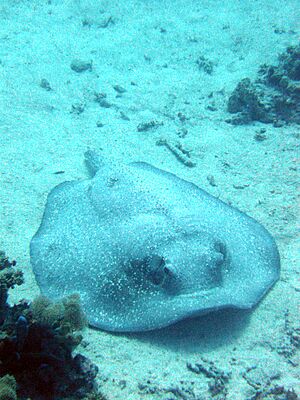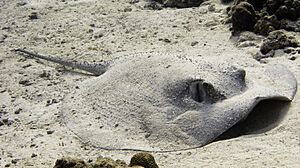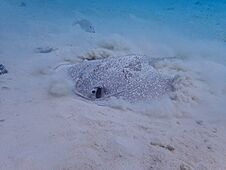Porcupine ray facts for kids
Quick facts for kids Porcupine ray |
|
|---|---|
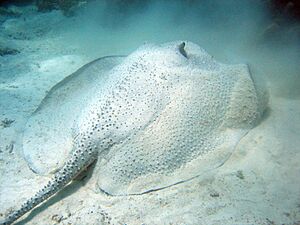 |
|
| Conservation status | |
| Scientific classification | |
| Genus: |
Urogymnus
|
| Species: |
asperrimus
|
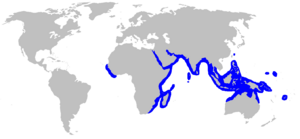 |
|
| Range of the porcupine ray | |
| Synonyms | |
|
|
The porcupine ray (Urogymnus asperrimus) is a special kind of stingray. It's a rare fish that lives on the ocean floor. You can find it in warm, tropical waters across the Indo-Pacific region and off West Africa.
This ray likes to live in sandy areas, among broken coral, or in seagrass beds. It usually stays in shallow waters, up to about 30 meters (100 feet) deep. The porcupine ray is big and heavy, growing up to 1.5 meters (5 feet) wide. It has a round, flat body and a thin tail. Unlike most stingrays, it doesn't have a venomous sting. Instead, it protects itself with many large, sharp thorns all over its body and tail.
Porcupine rays mostly eat small creatures that live on the seafloor, like worms and crabs. They also eat small fish. The mother ray nourishes her babies inside her body with a special "uterine milk." For a long time, people have used the ray's tough skin, called shagreen, for things like covering sword handles. Sadly, this ray is caught by accident in fishing nets. Because it's hard to handle due to its thorns, it's not a big commercial fish. However, too much fishing has made its numbers drop, so it's now listed as a Vulnerable animal.
Contents
What is a Porcupine Ray?
The porcupine ray is a unique type of ray. It's known for its tough, thorny skin. This ray is a "bottom-dweller," meaning it spends most of its time on the ocean floor.
Why is it called "Porcupine Ray"?
It gets its name from the many sharp thorns that cover its body. These thorns look a bit like the quills of a porcupine. They help the ray defend itself from predators.
How Big Do They Get?
Porcupine rays are quite large. They can grow to be about 1.2 to 1.5 meters (4 to 5 feet) wide. Their bodies are thick and round, almost like a pancake.
What Do They Look Like?
The porcupine ray has a round, flat body called a disc. Its snout is rounded, and it has small eyes followed by larger breathing holes called spiracles. Its mouth is on the underside of its body and has small bumps called papillae.
Its tail is thin and about the same length as its body. Unlike many other rays, it does not have a venomous stinging spine on its tail. Instead, its entire upper body, especially in older rays, is covered in sharp, tall thorns. The ray's color can be light to dark gray or brown on top, and white underneath. The tail often gets darker towards the tip.
Where Do Porcupine Rays Live?
Porcupine rays are found in many places, but they are not very common. They live along the coasts of the Indian Ocean, from South Africa all the way to Australia. You can also find them in the Pacific Ocean, near Indonesia, the Philippines, and Fiji. They even live off the coast of West Africa in the eastern Atlantic Ocean.
These rays prefer shallow waters, usually between 1 and 30 meters (3 to 100 feet) deep. They like sandy areas, places with broken coral, or beds of seagrass. Sometimes, they can even be found in water that is a mix of fresh and salt water, called brackish water.
What Do Porcupine Rays Eat?
The porcupine ray is a carnivore, meaning it eats other animals. Its main diet includes:
- Worms that live in the sand
- Crabs and other crustaceans
- Small bony fishes
When a porcupine ray hunts for food, it digs deep into the sand. You can often see a cloud of sand coming out of its spiracles as it searches for buried prey.
Reproduction and Life Cycle
The porcupine ray reproduces in a special way called aplacental viviparous. This means the mother carries her babies inside her body until they are ready to be born. The developing babies are fed by a special "uterine milk" that the mother produces.
Young porcupine rays often live in mangrove forests. These areas provide a safe place for them to grow. Males become ready to reproduce when they are about 90 centimeters (35 inches) wide. Females mature a bit later, at about 100 centimeters (39 inches) wide.
Porcupine Rays and Humans
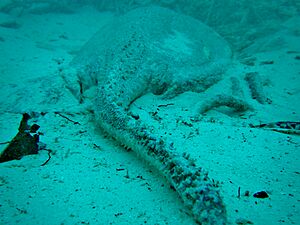
Even though porcupine rays don't have a venomous sting, their sharp thorns can still hurt people. However, they are often calm and let divers get close to them underwater.
Historical Uses of Their Skin
For many years, the tough, thorny skin of the porcupine ray was very valuable. It was made into a type of leather called shagreen. This shagreen was used for many things:
- It covered the handles of swords and other weapons, preventing hands from slipping during battle.
- The Malayans used it to cover their shields.
- In China, the skin was dyed and the thorns were ground down to create beautiful patterns for decoration.
- People on the Funafuti Atoll used dried parts of the ray's tail as a tool, like a rasp.
Current Status and Threats
Today, porcupine rays are often caught by accident in fishing nets, like trawls and beach seines. Their skin is still valued, and sometimes their meat and cartilage are used. In some places, like the Red Sea, their liver is eaten as a special dish.
However, it's hard for fishers to handle these rays because of their thorns, which limits their commercial value. Many of the coastal fisheries that catch porcupine rays are not regulated. This lack of rules has caused the number of porcupine rays to drop sharply in places like the Bay of Bengal and the Gulf of Thailand.
Other dangers to porcupine rays include damage to their habitat from coastal development. Also, if too many fish are caught, it can reduce the ray's food supply. Because of these threats, the International Union for Conservation of Nature has listed the porcupine ray as a Vulnerable animal. This means it needs protection to survive.



